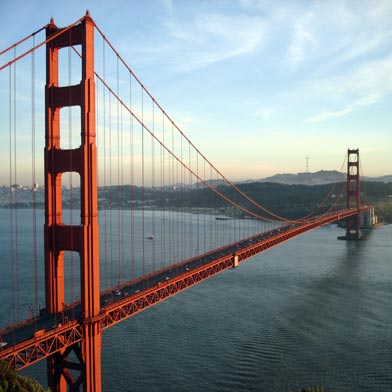 Earlier this week, the Golden Gate Bridge District approved a $4 million engineering study looking into the creation of a full-fledged suicide prevention barrier.
Earlier this week, the Golden Gate Bridge District approved a $4 million engineering study looking into the creation of a full-fledged suicide prevention barrier.
The proposal, which was originally approved by the board in 2008, consists of a series of hanging nets suspended approximately 20 feet below the bridge designed to catch anyone jumping or accidentally falling from the iconic San Francisco landmark
The overall cost of the project is expected to come in around the $50 million mark.
Outside of the $5 million grant the district secured for this early-stage study, none of the money needed to implement the project has been obtained. Since the project isn’t allowed to draw any of its funding from bridge toll revenue, and there’s little room in the state budget to carve out the remaining $45 million needed for full implementation, there’s a general consensus that if the suicide prevention system is to ever be built, its going to be done using federal funds.
According to Assemblyman, and former Golden Gate Bridge District Board Member, Tom Ammiano, there’s a lot of local energy devoted to getting funding for the barrier written into a new federal transportation bill–however that’s assuming Congress ever gets around to actually passing one.
This is the district’s eighth attempt at installing a suicide prevention barrier on the bridge since the board voted down a screen to prevent jumpers in 1940 for the same combination of aesthetic and financial reasons that have stymied every subsequent attempt.
Interestingly, in his original plans for the bridge, architect Joseph Strauss designed the railings to be nearly six feet tall as a way to discourage jumpers. By the time the bridge was finally constructed, the railings were lowered to a mere four feet and, as we know, many suicides have followed.
While not guaranteed to eliminate all suicides, physical barriers are said to be generally effective in significantly decreasing attempts at any given location. Suicide is often a very impulsive act, experts say, and anything on hand to give pause to someone considering killing themselves is likely to deter them from actually following though.
For example, in the years preceding the installation of a suicide barrier along Washington D.C.’s Ellington Bridge, an average of five people per year committed suicide by jumping off the bridge. That number has dropped to only one in five years–while the suicide rates at nearby bridges that didn’t install barriers has remained unchanged.
The Chronicle estimates that a minimum of 1,218 suicides have taken place on the bridge, a minimum of 19 per year–making it the single most suicide-prone location in the whole United States. Leaping from the bridge to the icy water below is usually fatal; people taking the 25 story plunge are killed 98% of the time.
The district is currently soliciting donations from individuals interested in helping pay for the installation of the barrier. Contributions can be mailed to: GGBHTD, P.O. Box 9000, Presidio Station, San Francisco, CA 94129, Attention: Accounting/Suicide Barrier.
A two-day celebration honoring the bridge’s 75th birthday is planned for next Memorial Day featuring the unveiling of renovations to some of the bridge’s facilities as well as tributes from cultural organizations such as the Marin Symphony Orchestra.
Spokeswoman Mary Currie told the Ex that the engineering study, which is expected to complete the design process for the barrier, should be finished by mid-2013.
Want more news, sent to your inbox every day? Then how about subscribing to our email newsletter? Here’s why we think you should. Come on, give it a try.









